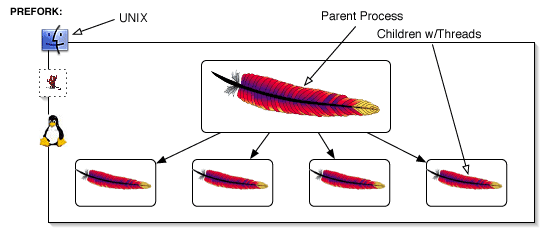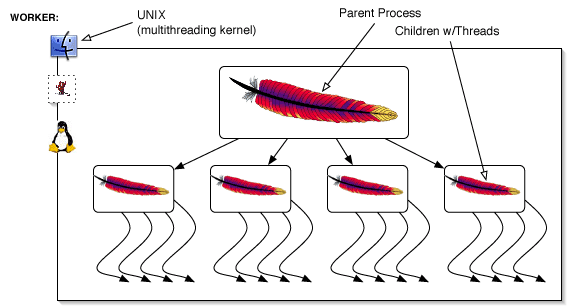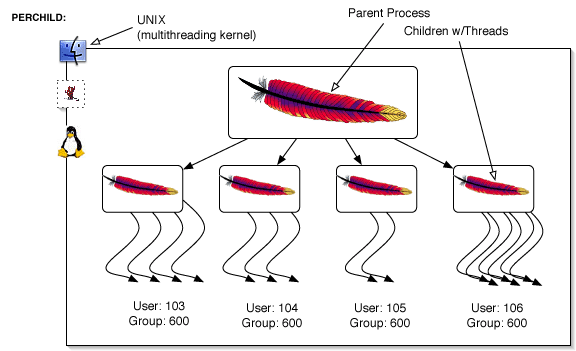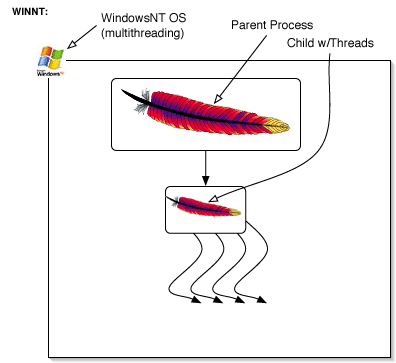I am going to configure in a way which meets my objectives for a production
OSX server:
Apache 2 has several options for dealing with processes, to encompass different
needs and different platforms. These are the MPM modules. There is more info
about all the options at the Apache
site, and I will briefly discuss three which are applicable for use with
OSX:
--with-mpm=choose_from_below
PREFORK
This is functionally equivalent to how everything worked in Apache
1.x era. A parent server process is started, and child processes are spawned
from it. The server keeps a few spawned children running, to handle incoming
requests- and the server can kill child processes if too many are started-
keeping the server from crashing. THIS IS WHY WE ALL LOVE APACHE.
The benefit of using this module is that it is a single-process model,
and lots of older Apache modules will work well with it- and be quite stable.
The downside of this module is that many systems take a performance
hit as new child processes are spawned as one process is handled at a time.

WORKER
This is what I'll use here- The worker module is much like the PREFORK
module, but is a hybrid thread/process MPM. This means that it behaves like
the PREFORK by spawning children, and these children spawn a static number
of threads. The worker then has one thread per child listening to the network,
and each process can serve many processes at once.
The benifits are sweet on OSX, seeing as the PPC is built to thrive
on multithreading. Speed, Stability, and Scalability are the key benefits
here.
The downside of this model is that writing modules which are stable
for multithreading is more complex, and developers are slower to adopt this.
If you are running experimental/3rd party modules, you'd be better off running
PREFORK.

PERCHILD
This one is really creepy. Perchild is like WORKER mpm, but each
child process, (running multiple threads), is run as a seperate user process.
Additionally, the child processes can run dynamic numbers of threads. This
means that security for CGI's can be extremely watertight. Now, if you want
to be running this module, it's a bit outside of the scope of this How-To,
and I'd hit the Apache website for more info: http://httpd.apache.org/docs-2.0/mpm.html.
If you see any really great uses of this module with Zope, PLEASE email me!
<[email protected]>

WINNT
Included here is a quick expination of how the Windows MPM works.
Essentially, windows users only have one option for Apache MPM's. The MPM
is designed to take the best advantage of WindowsNT architecture, and one
child process runs a static number of threads. It is designed using some windows-specific
stuff called AcceptEx, which helps to reduce the potency of DOS attaacks.
More information about windows and Apache can be found here:
http://www.serverwatch.com/stypes/servers/article.php/10881_1383231_2
But, since this how-to is for MAC OSX, I'll move on.

Proxy:
--enable-mod-proxy, and,
--enable-proxy-connect- are necessary for
Zope proxying.
--enable-proxy-ftp *new!*
- great for using Zope as a virtual host, could be used to set up name-based
ftp services to proxied Zope directories.
Cache:
--enable-file-cache is a very simple way to greatly improve
the performance of Apache, by caching the Apache config files etc...
disk-cache, mem-cache,
and straight cache DON'T SEEM TO COMPILE.
But really, if your doing any hardcore caching (aside from inside Zope),
might as well DROP Apache alltogether, in favor of a Squid-cache
<g>.